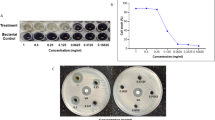Abstract
Hyaluronic acid (HA) has several clinical applications (aesthetic surgery, dermatology, orthopaedics and ophtalmology). Following recent evidence, suggesting antimicrobial and antiviral properties for HA, we investigated its effects on 15 ATCC strains, representative of clinically relevant bacterial and fungal species. The in vitro system employed allowed to assess optical density of broth cultures as a measure of microbial load in a time-dependent manner. The results showed that different microbial species and, sometimes, different strains belonging to the same species, are differently affected by HA. In particular, staphylococci, enterococci, Streptococcus mutans, two Escherichia coli strains, Pseudomonas aeruginosa, Candida glabrata and C. parapsilosis displayed a HA dose-dependent growth inhibition; no HA effects were detected in E. coli ATCC 13768 and C. albicans; S. sanguinis was favoured by the highest HA dose. Therefore, the influence of HA on bacteria and fungi warrants further studies aimed at better establishing its relevance in clinical applications.




Similar content being viewed by others
References
Romagnoli M, Belmontesi M. Hyaluronic acid-based fillers: theory and practice. Clin Dermatol. 2008;26:123–59.
Vazquez JR, Short B, Findlow AH, Nixon BP, Boulton AJ, Armstrong DG. Outcomes of hyaluronan therapy in diabetic foot wounds. Diabetes Res Clin Pract. 2003;59:123–7.
Slevin M, Krupinski J, Gaffney J, Matou S, West D, Delisser H, Savani RC, Kumar S. Hyaluronan-mediated angiogenesis in vascular disease: uncovering RHAMM and CD44 receptor signalling pathways. Matrix Biol. 2007;26:58–68.
Gao F, Yang CX, Mo W, Liu YW, He YQ. Hyaluronan oligosaccharides are potential stimulators to angiogenesis via RHAMM mediated signal pathway in wound healing. Clin Invest Med. 2008;31:106–16.
Campo GM, Avenoso A, Campo S, D’Ascola A, Nastasi G, Calatroni A. Molecular size hyaluronan differently modulates toll-like receptor-4 in LPS-induced inflammation in mouse chondrocytes. Biochimie. 2010;92:204–15.
Campo GM, Avenoso A, Campo S, D’Ascola A, Nastasi G, Calatroni A. Small hyaluronan oligosaccharides induce inflammation by engaging both toll-like-4 and CD44 receptors in human chondrocytes. Biochem Pharmacol. 2010;80:480–90.
Jiang D, Liang J, Noble PW. Hyaluronan as an immune regulator in human diseases. Physiol Rev. 2011;91:221–64.
Tiunnikov GI, Kostina GA, Radaeva IF, Bakulina LF. Effects of hyaluronic acid preparation on the development of herpetic infection in cell culture. Vopr Virusol. 2002;47:37–9.
Patterson RL, Peterson DA, Deinhardt F, Howard F. Rubella and rheumatoid arthritis: hyaluronic acid and susceptibility of cultured rheumatoid synovial cells to viruses. Proc Soc Exp Biol Med. 1975;149:594–8.
Cermelli C, Cuoghi A, Scuri M, Bettua C, Neglia RG, Ardizzoni A, Blasi E, Iannitti T, Palmieri B. In vitro evaluation of antiviral and virucidal activity of a high molecular weight hyaluronic acid. Virol J. 2011;8:141–8.
Costagliola C, Del Prete A, Winkler NR, Carpineto P, Ciancaglini M, Piccolomini R, Mastropasqua L. The ability of bacteria to use Na-hyaluronate as a nutrient. Acta Ophtalmol Scand. 1996;74:566–8.
Zhang M, McDonald FM, Sturrock SS, Charnock SJ, Humphery-Smith I, Black GW. Group A streptococcus cell-associated pathogenic proteins as revealed by growth in hyaluronic acid-enriched media. Proteomics. 2007;7:1379–90.
Pirnazar P, Wolinsky L, Nachnani S, Haake S, Pilloni A, Bernard GW. Bacteriostatic effects of hyaluronic acid. J Periodontol. 1999;70:370–4.
Bardavio J, Miserachs N, Favà P, Ollé M, Rodriguez Y. Estudio del crecimiento bacteriano in vitro en sustancias viscoelasticas. Annals d’Oftalmologia. 2003;11:239–44.
Carlson GA, Dragoo JL, Samimi B, Bruckner DA, Bernard GW, Hedrick M, Benhaim P. Bacteriostatic properties of biomatrices against common orthopaedic pathogens. Biochem Biophys Res Commun. 2004;321:472–8.
Tang ZH, Hou CL, Chen QQ. Experimental study on bacteriostasis of chitosan and sodium hyaluronate. Zhongguo Xiu Fu Chong Jian Wai Ke Za Zhi. 2002;16:259–61.
Kang JH, Kim YY, Chang JY, Kho HS. Influences of hyaluronic acid on the anticandidal activities of lysozyme and the peroxidase system. Oral Dis. 2011 (in press).
Lauderdale TL, Chapin KC, Murray PR. Reagents. In: Murray PR, Baron EJ, Pfaller MA, Tenover FC, Yolken RH, editors. Manual of clinical microbiology, 7th edn. ASM Press, Washington D.C.; 1999. pp. 1665–73.
Radaeva IF, Kostina GA, Il’ina SG, Kostyleva RN. Antimicrobial activity of hyaluronic acid. Zh Mikrobiol Epidemiol Immunobiol. 2001;1:74–5.
UNI EN 13697. Chemical disinfectants and antiseptics—Quantitative non-porous surface test for the evaluation of bactericidal and/or fungicidal activity of chemical disinfectants used in food, industrial, domestic and institutional areas—Test method and requirements without mechanical action (phase 2/step 2); 2001.
UNI EN 14349. Chemical disinfectants and antiseptics—Quantitative surface test for the evaluation of bacterial activity of chemical disinfectants and antiseptics used in veterinary field on non-porous surfaces without mechanical action—Test method and requirements (phase 2, step 2); 2005.
Wretlind B, Hedén L, Sjöberg L, Wadström T. Production of enzymes and toxins by hospital strains of Pseudomonas aeruginosa in relation to serotype and phage typing pattern. J Med Microbiol. 1973;6:91–100.
Brown MRW, Scott Foster JH, Clamp JR. Composition of Pseudomonas aeruginosa slime. J Biochem. 1969;112:521–5.
Acknowledgments
The Authors are grateful to IBSA (Institut Biochimique SA, CH-6903 Lugano), that founded part of the research activity and the salary of M.C.
Author information
Authors and Affiliations
Corresponding author
Rights and permissions
About this article
Cite this article
Ardizzoni, A., Neglia, R.G., Baschieri, M.C. et al. Influence of hyaluronic acid on bacterial and fungal species, including clinically relevant opportunistic pathogens. J Mater Sci: Mater Med 22, 2329 (2011). https://doi.org/10.1007/s10856-011-4408-2
Received:
Accepted:
Published:
DOI: https://doi.org/10.1007/s10856-011-4408-2




